

Compact Muon Solenoid
LHC, CERN
| CMS-PAS-FSQ-16-006 | ||
| Measurement of total and differential cross sections of central exclusive π+π− production in proton-proton collisions at 5.02 and 13 TeV | ||
| CMS Collaboration | ||
| June 2019 | ||
| Abstract: Central exclusive production of π+π− pairs is investigated with the CMS detector in proton-proton collisions at the LHC at center-of-mass energies of 5.02 and 13 TeV. The theoretical description of these non-perturbative processes, which are not sufficiently explored experimentally at the LHC, pose a significant challenge to models. The two exclusive pions are identified in the CMS silicon tracker based on specific energy loss, while the absence of other particles is ensured by calorimeter information. The total and differential cross sections of exclusive central π+π− production are measured as functions of invariant mass, transverse momentum, and rapidity of the π+π− system in the fiducial region defined as pT(π)> 0.2 GeV and |η(π)|< 2.4. The production cross sections in the four resonant channels f0(500), ρ0(770), f0(980), and f2(1270) are also measured. These results represent the first measurement of this process at the top LHC collision energy. | ||
|
Links:
CDS record (PDF) ;
CADI line (restricted) ;
These preliminary results are superseded in this paper, EPJC 80 (2020) 718. The superseded preliminary plots can be found here. |
||
| Figures | |

png pdf |
Figure 1:
Diagrams of continuum (a) and resonant (b) double pomeron exchange, and vector meson photoproduction (c), which are the dominant mechanisms for π+π− production via CEP in proton-proton collisions. |

png pdf |
Figure 2:
Left: The distribution of the mean energy loss and absolute value of momentum of tracks from low-multiplicity (Ntrack≤ 4) events collected at √s= 13 TeV. The π-selection region is shown in the 0.3-10 GeV/c range. All tracks outside this momentum range are identified as a pion. Right: The fit energy loss distributions in a given momentum bin with the sum of three Gaussian curves. Plots are similar for the 5.02 TeV data. |

png pdf |
Figure 2-a:
The distribution of the mean energy loss and absolute value of momentum of tracks from low-multiplicity (Ntrack≤ 4) events collected at √s= 13 TeV. The π-selection region is shown in the 0.3-10 GeV/c range. All tracks outside this momentum range are identified as a pion. |
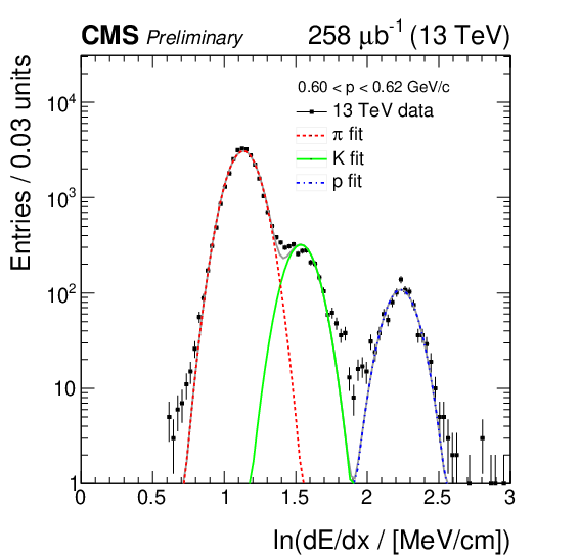
png pdf |
Figure 2-b:
The fit energy loss distributions in a given momentum bin with the sum of three Gaussian curves, from low-multiplicity (Ntrack≤ 4) events collected at √s= 13 TeV. |
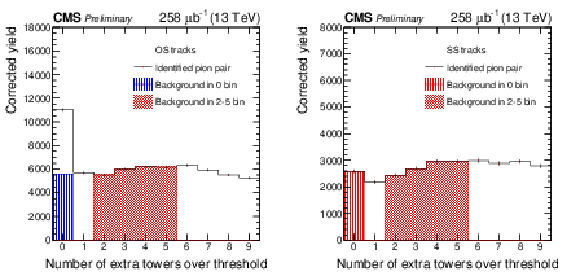
png pdf |
Figure 3:
The number of extra calorimeter towers over threshold in events containing an identified pion pair with opposite (left) and same (right) charge. The known contributions, denoted with the red hatched areas, are used to estimate the background in the zero bin of opposite-sign distribution, which is denoted by the blue hatched area. The error bars correspond to statistical uncertainties only. Plots are similar for 5.02 TeV data. |
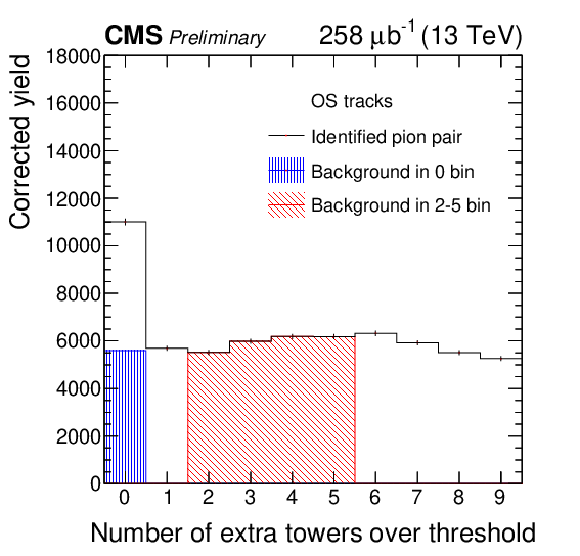
png pdf |
Figure 3-a:
The number of extra calorimeter towers over threshold in events containing an identified pion pair with opposite charge. The known contributions, denoted with the red hatched areas, are used to estimate the background in the zero bin of the distribution, which is denoted by the blue hatched area. The error bars correspond to statistical uncertainties only. |
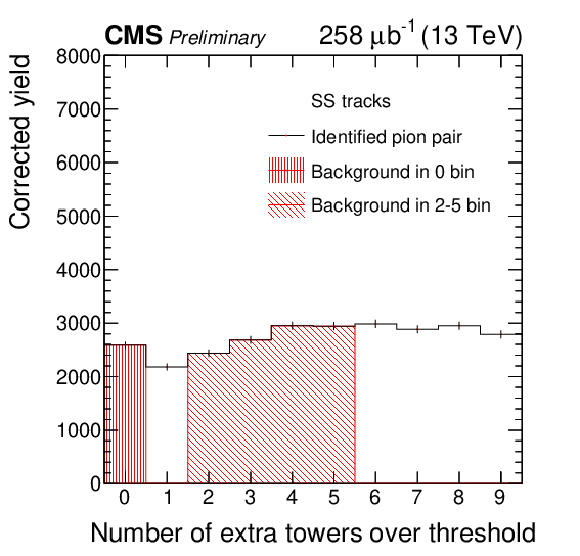
png pdf |
Figure 3-b:
The number of extra calorimeter towers over threshold in events containing an identified pion pair with same charge. The error bars correspond to statistical uncertainties only. |

png pdf |
Figure 4:
Background distributions as functions of kinematic variables estimated by data-driven methods. The proton dissociation background is not shown here, since it is accounted for via scaling of the final cross section values. The error bars correspond to statistical uncertainties. The results for the 5.02 TeV data set are similar. |
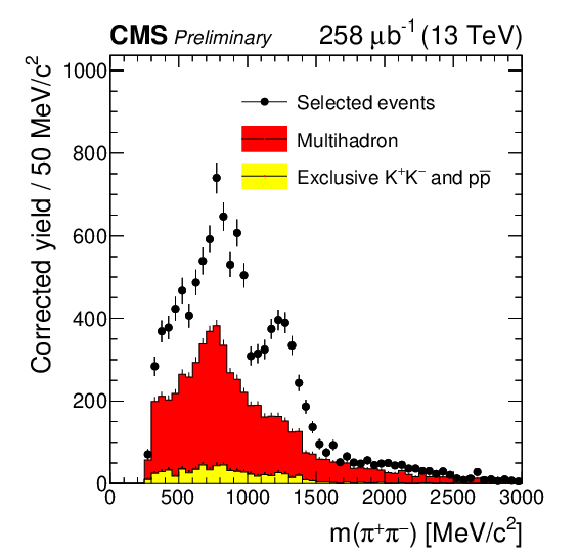
png pdf |
Figure 4-a:
Background distribution as function of m(π+π−) estimated by data-driven methods. The proton dissociation background is not shown here, since it is accounted for via scaling of the final cross section values. The error bars correspond to statistical uncertainties. |
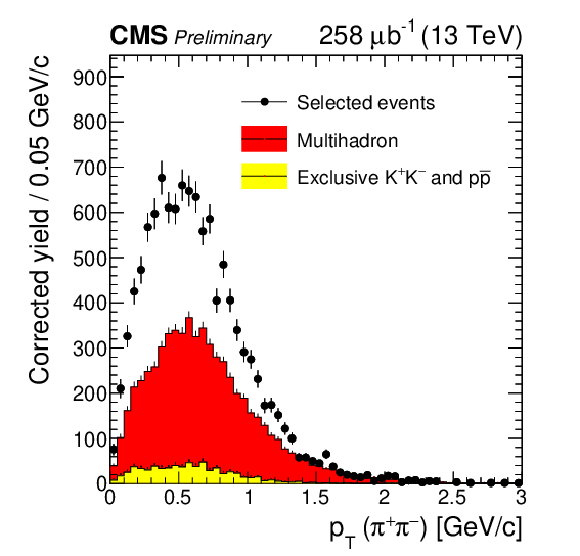
png pdf |
Figure 4-b:
Background distribution as function of pT(π+π−) estimated by data-driven methods. The proton dissociation background is not shown here, since it is accounted for via scaling of the final cross section values. The error bars correspond to statistical uncertainties. |

png pdf |
Figure 4-c:
Background distribution as function of y(π+π−) estimated by data-driven methods. The proton dissociation background is not shown here, since it is accounted for via scaling of the final cross section values. The error bars correspond to statistical uncertainties. |
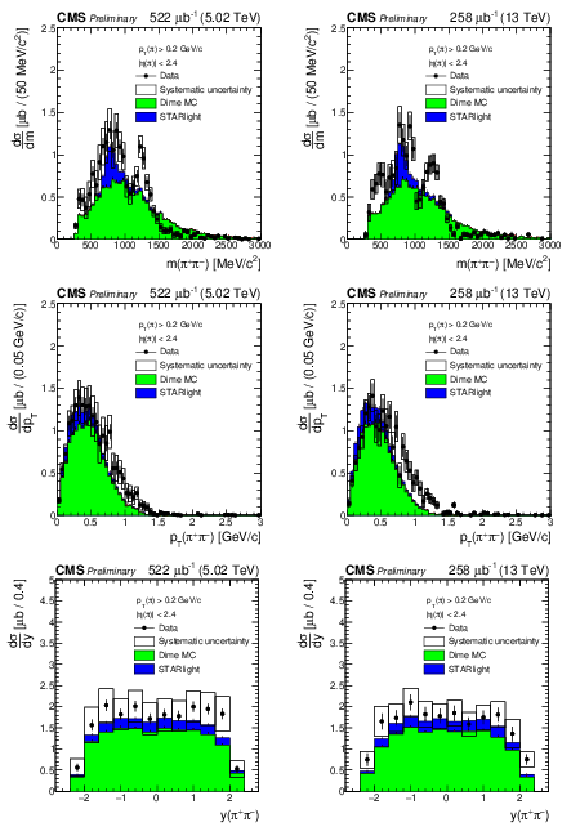
png pdf |
Figure 5:
Differential cross sections as functions of mass (upper row), transverse momentum (middle row), and rapidity (bottom row), compared with generator-level simulations for the 5.02 (left) and 13 TeV (right) data sets. The error bars correspond to statistical, while the open boxes correspond to systematic uncertainties. |
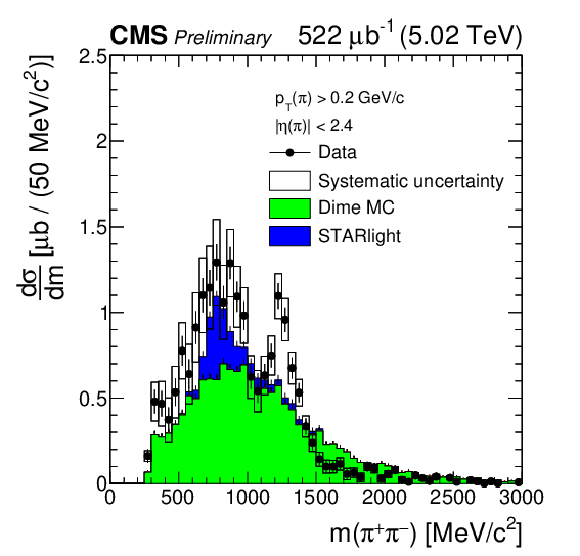
png pdf |
Figure 5-a:
Differential cross sections as functions of mass, compared with generator-level simulations for the 5.02 TeV data set. The error bars correspond to statistical, while the open boxes correspond to systematic uncertainties. |
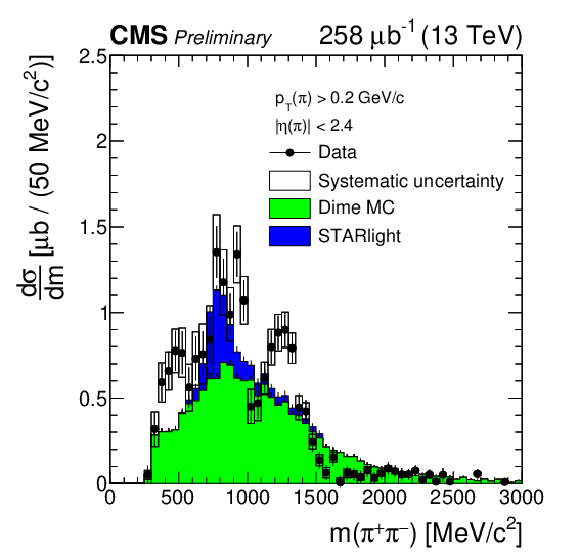
png pdf |
Figure 5-b:
Differential cross sections as functions of mass, compared with generator-level simulations for the 13 TeV data set. The error bars correspond to statistical, while the open boxes correspond to systematic uncertainties. |

png pdf |
Figure 5-c:
Differential cross sections as functions of transverse momentum, compared with generator-level simulations for the 5.02 TeV data set. The error bars correspond to statistical, while the open boxes correspond to systematic uncertainties. |
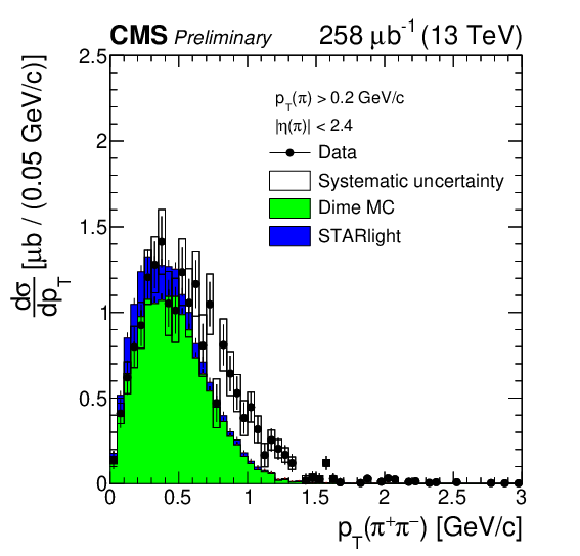
png pdf |
Figure 5-d:
Differential cross sections as functions of transverse momentum, compared with generator-level simulations for the 13 TeV data set. The error bars correspond to statistical, while the open boxes correspond to systematic uncertainties. |
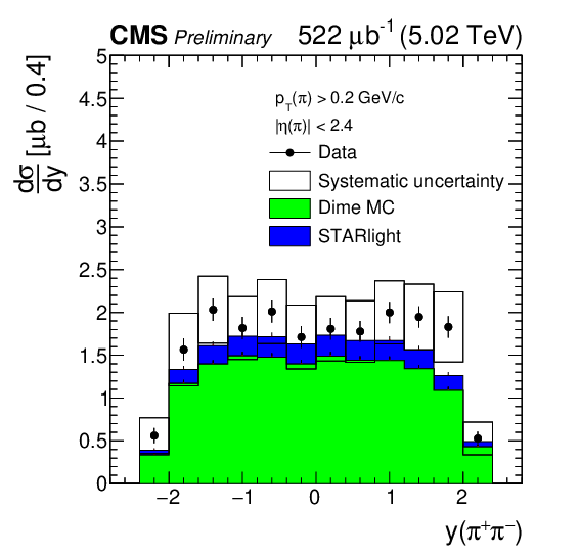
png pdf |
Figure 5-e:
Differential cross sections as functions of rapidity, compared with generator-level simulations for the 5.02 TeV data set. The error bars correspond to statistical, while the open boxes correspond to systematic uncertainties. |
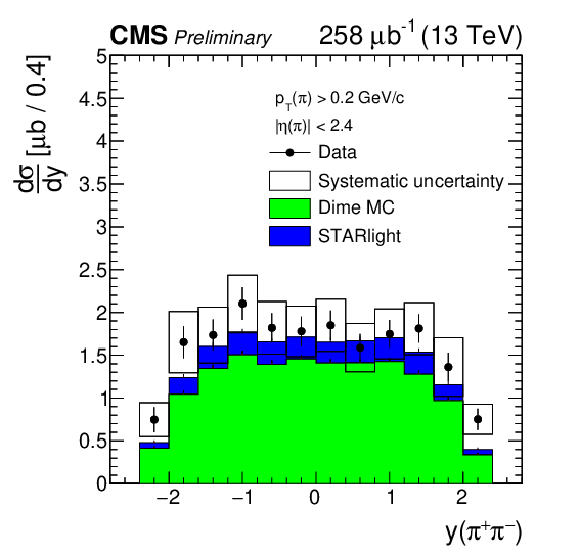
png pdf |
Figure 5-f:
Differential cross sections as functions of rapidity, compared with generator-level simulations for the 13 TeV data set. The error bars correspond to statistical, while the open boxes correspond to systematic uncertainties. |
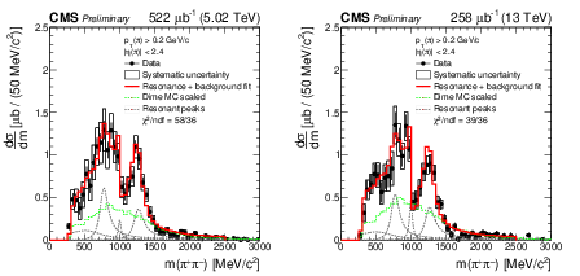
png pdf |
Figure 6:
Fit to the measured cross section with the sum of four interfering relativistic Breit-Wigner functions convolved with a normal distribution (to account for the the experimental resolution of the detector) for the 5.02 (left) and 13 TeV (right) data sets. The error bars correspond to statistical, while the open boxes correspond to systematic uncertainties. |
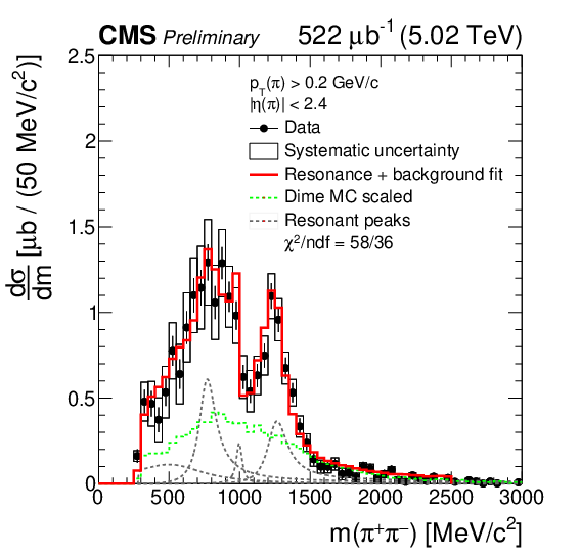
png pdf |
Figure 6-a:
Fit to the measured cross section with the sum of four interfering relativistic Breit-Wigner functions convolved with a normal distribution (to account for the the experimental resolution of the detector) for the 5.02 TeV data set. The error bars correspond to statistical, while the open boxes correspond to systematic uncertainties. |
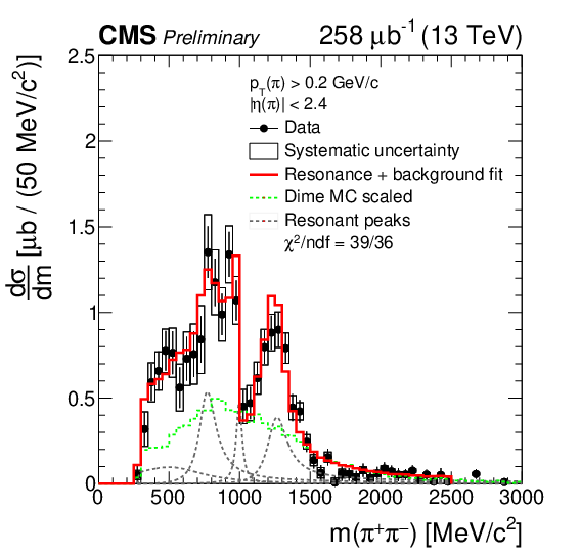
png pdf |
Figure 6-b:
Fit to the measured cross section with the sum of four interfering relativistic Breit-Wigner functions convolved with a normal distribution (to account for the the experimental resolution of the detector) for the 13 TeV data set. The error bars correspond to statistical, while the open boxes correspond to systematic uncertainties. |
| Tables | |

png pdf |
Table 1:
The value of calorimeter thresholds for different calorimeter constituents, used in the selection of exclusive events. |
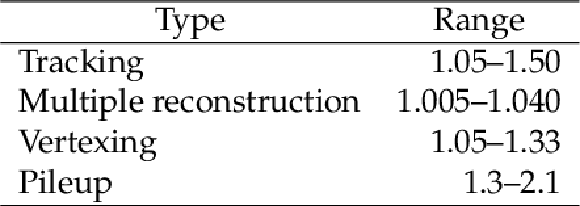
png pdf |
Table 2:
Correction factors. |

png pdf |
Table 3:
Checking the validity of Eq. (10) by comparing the true and predicted number of background events in inclusive MC samples. |

png pdf |
Table 4:
The semiexclusive/exclusive ratio R calculated from different MC event generators. |
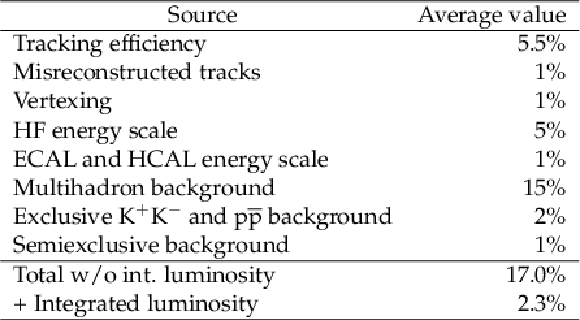
png pdf |
Table 5:
The sources and average values of systematic uncertainties, used as the systematic uncertainty of the total cross section. |
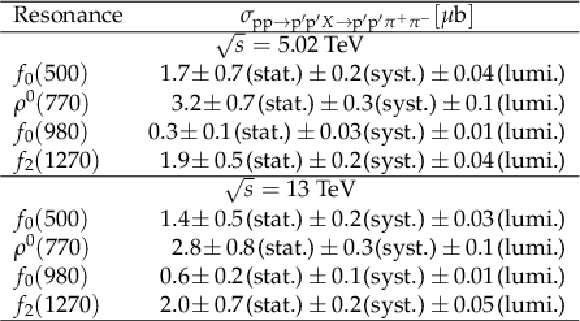
png pdf |
Table 6:
Cross sections of the resonant processes in the pT(π)> 0.2 GeV/c, |η(π)|< 2.4 fiducial region, calculated from Breit-Wigner fits. The STARlight predictions for pp→p′p′ρ0→p′p′π+π− processes are 2.3 and 3.0 μb for 5.02 and 13 TeV respectively, which is compatible with the fit results. |
| Summary |
| The cross sections of various central exclusive production processes have been measured in pp collisions at 5.02 and 13 TeV center-of-mass energies. Exclusive events are selected by vetoing additional energy deposits in the calorimeters and by requiring two oppositely charged pions identified via their mean energy loss in the tracker detectors. These events are used together with correction factors to obtain invariant mass, transverse momentum, and rapidity distributions of the π+π− system. Four resonant peaks can be identified in the mass spectrum: f0(500), ρ0(770), f0(980), and f2(1270), which are fitted with the sum of four interfering Breit-Wigner functions. There is an indication that the DIME MC model overestimates the high invariant mass region of the exclusive pion pair. The measured total exclusive π+π− production cross section is 19.6 ± 0.4 (stat) ± 3.3 (syst) ± 0.01 (lumi) μb and 19.0 ± 0.6 (stat) ± 3.2 (syst) ± 0.01 (lumi) μb for 5.02 and 13 TeV, respectively. The exclusive production cross section of the resonances are also measured. The cross sections of ρ0(770) production are consistent with the STARlight model prediction. |
| References | ||||
| 1 | P. Lebiedowicz and A. Szczurek | Exclusive pp→ppπ+π− reaction: From the threshold to LHC | Phy. Rev. D 81 (2010) 036003 | 0912.0190 |
| 2 | P. Lebiedowicz, O. Nachtmann, and A. Szczurek | Central exclusive diffractive production of π+π− continuum, scalar and tensor resonances in pp and pˉp scattering within tensor pomeron approach | PRD 93 (2016) 054015 | 1601.04537 |
| 3 | P. Lebiedowicz, O. Nachtmann, and A. Szczurek | ρ0 and Drell-Soding contributions to central exclusive production of π+π− pairs in proton-proton collisions at high energies | PRD 91 (2015) 074023 | 1412.3677 |
| 4 | A. Bolz et al. | Photoproduction of π+π− pairs in a model with tensor-pomeron and vector-odderon exchange | JHEP 01 (2015) 151 | 1409.8483 |
| 5 | WA102 Collaboration | A partial wave analysis of the centrally produced K+K− and K0SK0S systems in pp interactions at 450 GeV/c and new information on the spin of the fJ(1710) | PLB 453 (1999) 305 | hep-ex/9903042 |
| 6 | WA102 Collaboration | A partial wave analysis of the centrally produced π0π0 system in pp interactions at 450 GeV/c | PLB 453 (1999) 325 | hep-ex/9903044 |
| 7 | WA102 Collaboration | A partial wave analysis of the centrally produced π+π− system in pp interactions at 450 GeV/c | PLB 453 (1999) 316 | hep-ex/9903043 |
| 8 | ABCDHW Collaboration | Production of the f0 meson in the double pomeron exchange reaction pp→ppπ+π− at √s= 62 GeV | Z. Phys. C 31 (1986) 185 | |
| 9 | ABCDHW Collaboration | The reaction Pomeron-Pomeron →π+π− and an unusual production mechanism for the f2(1270) | Z. Phys. C 48 (1990) 569 | |
| 10 | ABCDHW Collaboration | Evidence for f2(1720) production in the reaction Pomeron-Pomeron →π+π−π+π− | Z. Phys. C 58 (1993) 251 | |
| 11 | Axial-Field Spectrometer Collaboration | A search for glueballs and a study of double Pomeron exchange at the CERN Intersecting Storage Rings | NPB 264 (1985) 154 | |
| 12 | CDF Collaboration | Measurement of central exclusive π+π− production in pˉp collisions at √s= 0.9 and 1.96~TeV at CDF | PRD 91 (2015) 091101 | arXiv:1502.01391 |
| 13 | H1 Collaboration | Elastic photoproduction of J/ψ and Υ mesons at HERA | PLB 483 (2000) 23 | hep-ex/0003020 |
| 14 | ZEUS Collaboration | Exclusive photoproduction of Υ mesons at HERA | PLB 680 (2009) 4 | 0903.4205 |
| 15 | J. R. Forshaw and D. A. Ross | Quantum Chromodynamics and the Pomeron | Cambridge University Press, 1997 , ISBN 9780511524387 | |
| 16 | S. Donnachie, G. Dosch, P. Landshoff, and O. Nachtmann | Pomeron Physics and QCD | Cambridge University Press, 2002 , ISBN 9780511534935 | |
| 17 | W. Ochs | The Status of Glueballs | JPG 40 (2013) 043001 | 1301.5183 |
| 18 | Particle Data Group, M. Tanabashi et al. | Review of particle physics | PRD 98 (2018) 030001 | |
| 19 | S. Okubo | Phi meson and unitary symmetry model | PL5 (1963) 165 | |
| 20 | G. Zweig | An SU(3) model for strong interaction symmetry and its breaking. version 2 | in Developments in the quark theory of hadrons. VOL. 1. 1964 - 1978, D. Lichtenberg and S. P. Rosen, eds., p. 221964 | |
| 21 | J. Iizuka | Systematics and phenomenology of meson family | Prog. Theor. Phys. Suppl. 37 (1966) 21 | |
| 22 | CMS Collaboration | Description and performance of track and primary-vertex reconstruction with the CMS tracker | JINST 9 (2014) P10009 | CMS-TRK-11-001 1405.6569 |
| 23 | CMS Collaboration | The CMS trigger system | JINST 12 (2017) P01020 | CMS-TRG-12-001 1609.02366 |
| 24 | CMS Collaboration | The CMS experiment at the CERN LHC | JINST 3 (2008) S08004 | CMS-00-001 |
| 25 | CMS Collaboration | Measurement of diffraction dissociation cross sections in pp collisions at √s= 7 TeV | PRD 92 (2015), no. 1, 012003 | CMS-FSQ-12-005 1503.08689 |
| 26 | T. Sjostrand et al. | An Introduction to PYTHIA 8.2 | CPC 191 (2015) 159 | 1410.3012 |
| 27 | CMS Collaboration | Event generator tunes obtained from underlying event and multiparton scattering measurements | EPJC 76 (2016), no. 3, 155 | CMS-GEN-14-001 1512.00815 |
| 28 | R. Ciesielski and K. Goulianos | MBR Monte Carlo Simulation in PYTHIA8 | PoS ICHEP2012 (2013) 301 | 1205.1446 |
| 29 | K. Werner, F.-M. Liu, and T. Pierog | Parton ladder splitting and the rapidity dependence of transverse momentum spectra in deuteron-gold collisions at RHIC | PRC 74 (2006) 044902 | hep-ph/0506232 |
| 30 | T. Pierog et al. | EPOS LHC: Test of collective hadronization with data measured at the CERN Large Hadron Collider | PRC 92 (2015) 034906 | 1306.0121 |
| 31 | H. J. Drescher et al. | Parton based Gribov-Regge theory | PR 350 (2001) 93 | hep-ph/0007198 |
| 32 | S. R. Klein and J. Nystrand | Photoproduction of quarkonium in proton-proton and nucleus-nucleus collisions | PRL 92 (2004) 142003 | |
| 33 | L. A. Harland-Lang, V. A. Khoze, and M. G. Ryskin | Modelling exclusive meson pair production at hadron colliders | EPJC 74 (2014) 2848 | 1312.4553 |
| 34 | GEANT4 Collaboration | GEANT4--a simulation toolkit | NIMA 506 (2003) 250 | |
| 35 | L. Quertenmont | Particle identification with ionization energy loss in the CMS silicon strip tracker | NPPS 215 (2011) 95 | |
| 36 | CMS Collaboration | Study of the inclusive production of charged pions, kaons, and protons in pp collisions at √s= 0.9 , 2.76, and 7 TeV | EPJC 72 (2012) 2164 | CMS-FSQ-12-014 1207.4724 |
| 37 | TOTEM Collaboration | First measurement of elastic, inelastic and total cross-section at √s= 13 tev by TOTEM and overview of cross-section data at LHC energies | EPJC 79 (2019), no. 2, 103 | 1712.06153 |
| 38 | CMS Collaboration | Measurement of the inelastic proton-proton cross section at √s= 13 tev | JHEP 07 (2018) 161 | CMS-FSQ-15-005 1802.02613 |
| 39 | CMS Collaboration | Energy calibration and resolution of the CMSelectromagnetic calorimeter in pp collisions at √s= 7 ~tev | JINST 8 (2013) P09009 | CMS-EGM-11-001 1306.2016 |
| 40 | CMS Collaboration | CMS luminosity calibration for the pp reference run at √s= 5.02 TeV | CMS-PAS-LUM-16-001 | CMS-PAS-LUM-16-001 |
| 41 | CMS Collaboration | CMS luminosity measurement for the 2015 data-taking period | CMS-PAS-LUM-15-001 | CMS-PAS-LUM-15-001 |
| 42 | J. D. Jackson | Remarks on the phenomenological analysis of resonances | Il Nuovo Cim. 34 (1964) 1644 | |
| 43 | R. Garcia-Martin, R. Kaminski, J. R. Pelaez, and J. Ruiz de Elvira | Precise determination of the f0(600) and f0(980) pole parameters from a dispersive data analysis | PRL 107 (2011) 072001 | 1107.1635 |

|
Compact Muon Solenoid LHC, CERN |

|

|

|

|

|

|